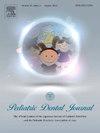Oral manifestations of tuberous sclerosis complex: A systematic review
IF 0.6
Q4 DENTISTRY, ORAL SURGERY & MEDICINE
引用次数: 0
Abstract
Background
A heritable neurocutaneous condition known as Tuberous Sclerosis Complex (TSC), is characterized by multisystem involvement with multiple hamartomatous tumors, seizures, intellectual disability, and facial angiofibroma affects the human body.
Aim
We aim to study the literature and highlight all the oral and dental manifestations encountered in TSC patients.
Materials and methods
Published articles having a population of tuberous sclerosis patients with oral manifestations, regardless of age or gender, and articles written in English were included. An electronic search was conducted in the PubMed, Google Scholar, Lilac, EBSCO, and SciELO databases from 1964 to 2023. Google Scholar articles were searched and selected manually. To calculate the risk of bias, the Joanna Briggs Institute critical appraisal criteria for quality evaluation was used.
Results
A total of 37 articles were selected out of 1203 in which only case reports (CR) and cross-sectional studies (CS) [descriptive (CS-D) & analytical (CS-A)] met the eligibility criteria. The present systematic review is qualitative. The risk of bias for case reports, 35.7% (n = 10) received a low grade while 57.14% (n = 16) received a moderate grade. For cross-sectional studies, 33.3% (n = 3) received a moderate grade, while 11.1% (n = 1) received a low score. The primary oral outcomes were dental enamel pitting (60% in CR, 79% in CS-D, and 96% in CS-A). gingival growth/hyperplasia/enlargement, (63% in CR, 37.6% in CS-D, and 14% in CS-A), and intra-oral fibroma (18% in CR, 39% in CS-D, and 14% in CS-A). Other secondary oral manifestations were intra-oral hypopigmented macule (n = 3, CR), enamel hypoplasia of teeth (10% in CR, 11.7% in CS-A), dental anomalies like enamel pearl (9.9% in CS-D), odontogenic tumors like desmoplastic fibromas (n = 1, CR), odontogenic myxoma in the jaws (n = 2, CR), hemangioma of the tongue (n = 1, CR) compound odontoma (n = 1, CR), angiomyolipoma (n = 1, CR), and impacted teeth (10%, CR).
Conclusion
Dental enamel pitting, gingival hyperplasia, and intra-oral fibroma are the most common oral manifestations in TSC patients. Other features included intra-oral hypopigmented macules, enamel hypoplasia of teeth, gingival angiofibroma, and dental anomalies such as enamel pearls.
结节性硬化症复合体的口腔表现:系统综述
结节性硬化症(TSC)是一种遗传性神经皮肤疾病,其特点是累及多系统,可累及多个错构瘤、癫痫、智力残疾和面部血管纤维瘤,影响人体。目的:我们的目的是研究文献,突出TSC患者所遇到的所有口腔和牙齿表现。材料和方法纳入已发表的涉及有口腔表现的结节性硬化症患者的文章,不论年龄或性别,以及以英文撰写的文章。电子检索PubMed、b谷歌Scholar、Lilac、EBSCO和SciELO数据库,检索时间为1964年至2023年。谷歌学者文章是手工搜索和选择的。为了计算偏倚风险,采用了乔安娜布里格斯研究所质量评价的关键评价标准。结果从1203篇文章中筛选出37篇,其中只有病例报告(CR)和横断面研究(CS)[描述性研究(CS- d) &;分析(CS-A)]符合合格标准。目前的系统评价是定性的。病例报告的偏倚风险,35.7% (n = 10)为低等级,57.14% (n = 16)为中等等级。在横断面研究中,33.3% (n = 3)获得中等评分,11.1% (n = 1)获得低分。主要的口腔结局是牙釉质凹陷(CR组60%,CS-D组79%,CS-A组96%)。牙龈生长/增生/增大(CR 63%, CS-D 37.6%, CS-A 14%)和口腔内纤维瘤(CR 18%, CS-D 39%, CS-A 14%)。其他继发性口腔表现为口腔内低色素斑(n = 3, CR)、牙釉质发育不全(CR组占10%,CS-A组占11.7%)、牙釉质珍珠等牙齿异常(CS-D组占9.9%)、牙源性肿瘤如结缔组织纤维瘤(n = 1, CR)、颌骨牙源性黏液瘤(n = 2, CR)、舌血管瘤(n = 1, CR)、复合牙瘤(n = 1, CR)、血管平滑肌脂肪瘤(n = 1, CR)、阻生牙(10%,CR)。结论牙釉质凹陷、牙龈增生、口腔内纤维瘤是TSC患者最常见的口腔表现。其他特征包括口腔内色素沉着斑、牙齿釉质发育不全、牙龈血管纤维瘤和牙釉质珍珠等牙齿异常。
本文章由计算机程序翻译,如有差异,请以英文原文为准。
求助全文
约1分钟内获得全文
求助全文
来源期刊

Pediatric Dental Journal
DENTISTRY, ORAL SURGERY & MEDICINE-
CiteScore
1.40
自引率
0.00%
发文量
24
审稿时长
26 days
 求助内容:
求助内容: 应助结果提醒方式:
应助结果提醒方式:


